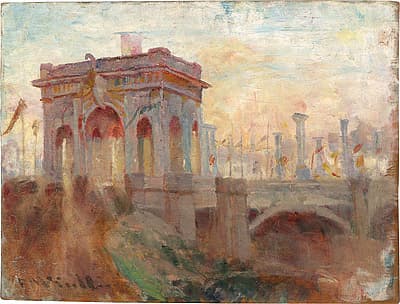Frederick
MCCUBBIN
Australia
1855
–
1917
Triumphal Arch at Princes Bridge, Melbourne
[(Arrival of the Duke and Duchess of Cornwall and York in 1901 to open the first Federal Parliament)]
1901
oil on pine panel
signed l.l., oil "F. McCubbin", not dated
26.0 (h)
x 34.4 (w)
cm
Given by Hugh McCubbin to the Commonwealth as a first hand record of a great historical event and to mark the centenary of the birth of Frederick McCubbin, 1955
National Gallery of Australia, Canberra
NGA 1959.28
In this small sketch McCubbin depicted the arrival of the Duke and Duchess of Cornwall and York, to open the first Federal Parliament in the Melbourne Exhibition Building on Friday 9 May 1901. The triumphal arch dominates the composition on the left, connecting the dark, scumbled foreground with the gold brushstrokes of the sky. McCubbin suggested the procession through the columns with the fluttering banners. Although he did not depict any figures, he created a sense of pageantry.
This oil was ‘painted on the spot’, but McCubbin ‘took some liberties with the subject by leaving out the unsightly “screen”, which was placed at the near end of the bridge’ (McCubbin 1949). He explored this subject more fully in his large-scale painting, Arrival of the Duke and Duchess of York, Melbourne, 1901 (cat 10), completed after his return from Europe in 1907.
The temporary Civic Arch was designed by the architect Harold Desbrowe-Annear for the triumphal procession. Placed near the centre of Princes Bridge, it transformed the bridge into an imposing gateway to Melbourne. The structure was similar to the Arc de Triomphe (1808) in Paris, and the Marble Arch (1828) in London, which followed the model of the Roman triumphal arches. It included the French motto from the British coat-of-arms (‘Dieu et mon droit’), and the Latin motto of the City of Melbourne (‘Vires acquirit eundo’).Extending from the arch was the bow of an ancient barge, with six oars inscribed with the names of the States. A lion’s head symbolised the Empire. The arch was intended to stand for 12 months. Sadly, however, only two weeks after the celebrations it was already beginning to deteriorate. (The arch was one of nine temporary ceremonial arches built in Melbourne in May 1901 for the Duke and Duchess’s visit.)
